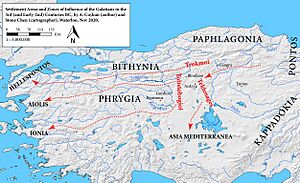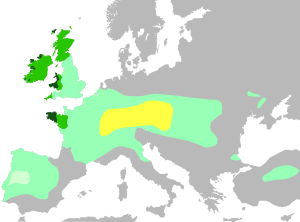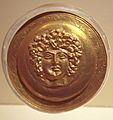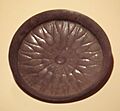Galatia facts for kids
Quick facts for kids Galatia |
|
|---|---|
| Ancient region of Anatolia | |
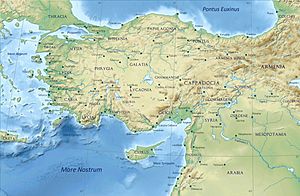
Anatolia in the Greco-Roman period. The classical regions and their main settlements, including Galatia.
|
|
| Location | Central Anatolia, Turkey |
| State existed | 280–64 BC |
| Successive languages | Galatian, Greek |
| Achaemenid satrapy | Cappadocia |
| Roman province | Galatia |
Galatia (/ɡəˈleɪʃə/; Ancient Greek: Γαλατία, Galatía) was an old region in the middle of Anatolia. Today, this area is part of Turkey, near the cities of Ankara and Eskişehir.
Galatia got its name from a group of people called the Gauls. These Gauls came from a place called Thrace (which is now part of Bulgaria and Greece). They moved into Anatolia in the 3rd century BC. This happened after a big event called the Gallic invasion of the Balkans in 279 BC. Because these Gauls settled there, Galatia was sometimes called the "Gaul of the East."
Contents
Where Was Ancient Galatia?
Galatia was surrounded by other ancient regions. To the north were Bithynia and Paphlagonia. To the east, you would find Pontus and Cappadocia. South of Galatia were Cilicia and Lycaonia. Finally, to the west was Phrygia.
The main city and capital of Galatia was Ancyra. Today, Ancyra is known as Ankara, which is the capital city of modern Turkey.
The Celtic Galatians
The people living in Galatia were called "Galatians" by the Greeks. They were actually three different groups of Celts who had moved to Anatolia. These groups were the Tectosages, the Trocmii, and the Tolistobogii.
Over time, these Celts started to adopt Greek customs and language. This process is called Hellenization. By the 1st century BC, they had become so much like the Greeks that some writers called them Hellenogalatai, meaning "Greek-Galatians." The Romans called them Gallograeci, or "Greek Gauls." Even though they blended in, the Galatians kept their own language and identity for a long time.
How the Celts Arrived in Anatolia
By the 4th century BC, Celtic groups had moved into the Balkans. Here, they met people like the Thracians and Greeks. In 380 BC, some Celts fought in what is now Croatia. There were even stories that Alexander the Great's father, Philip II of Macedonia, was killed with a Celtic dagger.
In 335 BC, some Celts met Alexander the Great during one of his campaigns. Ancient stories also say that Celts helped Dionysius I of Syracuse fight alongside the Macedonians against the Thebans.
A big event happened in 279 BC. Two Celtic groups, led by a chief named Brennus, moved south towards the Greek states. A large part of this group then decided to head towards Asia Minor (which is another name for Anatolia).
For a few years, cities near the Hellespont (a narrow strait) stopped the Celts from entering Asia Minor. But then, a ruler named Nikomedes I of Bithynia hired 20,000 Galatian fighters to help him in a power struggle.
After helping Nikomedes, the Galatians became independent. They started raiding Greek cities in Asia Minor. They looted places like Cyzikus, Ilion, and Didyma. Some cities, like Erythras, even paid them money to leave them alone.
Around 275 or 269 BC, the army of Antiochus fought the Galatians in a big battle. After this battle, the Celts settled in northern Phrygia. This area then became known as Galatia.
The main cities in Celtic Galatia included Ancyra (modern Ankara), Pessinus, Tavium, and Gordion.
Galatia Under Roman Rule
After the death of their king, Deiotarus, the Kingdom of Galatia was given to Amyntas. He was a commander in the Roman army. When Amyntas died in 25 BC, the Roman emperor Augustus made Galatia a Roman province.
Near Ancyra, the king's heir, Pylamenes, rebuilt a temple to honor Augustus. This showed their loyalty to Rome. On the walls of this temple, an important text called the Res Gestae of Augustus was preserved. This text tells us a lot about Augustus's life and achievements. Galatia was one of the provinces most loyal to Rome.
The Christian apostle Paul the Apostle visited Galatia during his travels. He later wrote a letter to the Christians there, which is known as the Epistle to the Galatians in the Bible.
Even though the Galatians had a strong culture at first, they slowly became more like the Greek-speaking people of Anatolia. This process continued for centuries. However, the Galatian language was still spoken in the time of St. Jerome (around 347–420 AD). He wrote that the Galatians in Ancyra spoke the same language as people in Trier, which is now in Germany. This language was a type of Gaulish.
Later, around 386–395 AD, Galatia was split into two new provinces: Galatia Prima and Galatia Secunda. The Galatian people eventually blended into the Greek-speaking populations of Anatolia.
Images for kids
-
A Galatian's head as depicted on a gold Thracian objet d'art, 3rd century BC. Istanbul Archaeological Museum.
-
Galatian bracelets and earrings, 3rd century BC, Hidirsihlar tumulus, Bolu. Istanbul Archaeological Museum.
-
Galatian torcs, 3rd century BC, Hidirsihlar tumulus, Bolu. Istanbul Archaeological Museum.
See also
- Ancient regions of Anatolia
- History of Anatolia


